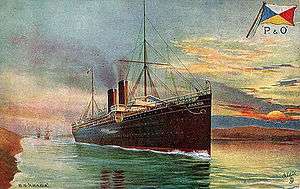RMS Arabia
RMS Arabia was a P&O ocean liner. She was sunk in the Mediterranean in 1916 by a German U-boat during World War I.
 RMS Arabia in a pre-war postcard | |
| History | |
|---|---|
| Name: | RMS Arabia |
| Namesake: | Arabia |
| Owner: |
|
| Port of registry: |
|
| Route: | Tilbury – Bombay (1898–1914) |
| Builder: | Caird & Company, Greenock[1] |
| Cost: | £250,000 |
| Yard number: | 286 |
| Launched: | 10 November 1897[1] |
| Completed: | 12 March 1898[1] |
| Identification: |
|
| Fate: | Sunk by torpedo, 6 November 1916 |
| General characteristics | |
| Type: | ocean liner |
| Tonnage: | 7,903 GRT,[1] 4,167 NRT |
| Length: | 499.9 feet (152.4 m) (pp) |
| Beam: | 54 feet (16 m) |
| Draught: | 26 feet 9 inches (8.15 m) |
| Depth: | 37.6 feet (11.5 m) |
| Installed power: | 11,000 ihp |
| Propulsion: | |
| Speed: | service: 16.5 knots (30.6 km/h)[1] Max: 18 kn (33 km/h) |
| Capacity: |
|
| Troops: | 2,500 |
| Crew: | 283 (116 Europeans and 167 Lascars) |
| Notes: | Sister ships: China, Egypt, India, Persia |
History
Caird & Company built Arabia at Greenock on the River Clyde, launching her in November 1897 and completing her in March 1898. She had capacity for 317 first class and 152 second class passengers, a total of 469.[2] She was the first ocean liner to have a children's playroom.
Arabia's route was between Tilbury and Bombay. On her maiden voyage she took Lord Kedleston to take up his post as Viceroy of India. In 1902 she took passengers to India for the 1903 Delhi Durbar.[2]
On 15 March 1905 the 4,206 GRT cargo steamship Riverdale was manœuvreing in Bombay Harbour when she struck Arabia amidships on her port side, damaging the liner's promenade deck, boat deck and upper works. The collision was caused by Riverdale's chief engineer inexplicably setting her engine to go ahead when ordered to go astern.[3]
On 12 October 1912 the steamship Powerful collided with Arabia in the English Channel off Southampton. Powerful's bow holed the crew WC above the waterline, crushing lascar crewman Hassan Moosa to death.[2]
In 1915 and 1916 Arabia made three voyages between Britain and Australia. On 6 November 1916 she was en route from Sydney via Fremantle, Western Australia to England when the German submarine UB-43 torpedoed her without warning 97 nautical miles (180 km) south by west of Cape Matapan, Greece, killing 11 of her engine room crew. Arabia launched her boats within 15 minutes. Four armed trawlers and Ellerman Lines' 8,204 GRT passenger liner City of Marseilles rescued survivors.[2]
187 Australians were aboard Arabia.[4] Her sinking helped surge volunteer enlistment in the Australian armed forces.
Notes
- "Arabia (1105587)". Miramar Ship Index. Retrieved 12 February 2009.
- "Arabia (1898" (PDF). Fact Sheet. P&O Heritage. June 2009. Archived from the original (PDF) on 24 September 2015. Retrieved 30 January 2015.
- ""Riverdale" (S.S.) and "Arabia" (S.S.)" (PDF). PortCities Southampton. 28 March 1905. Retrieved 30 January 2015.
- Law, Tim. ""Here she comes!"". Stories. Retrieved 30 January 2015.